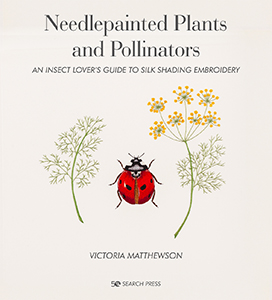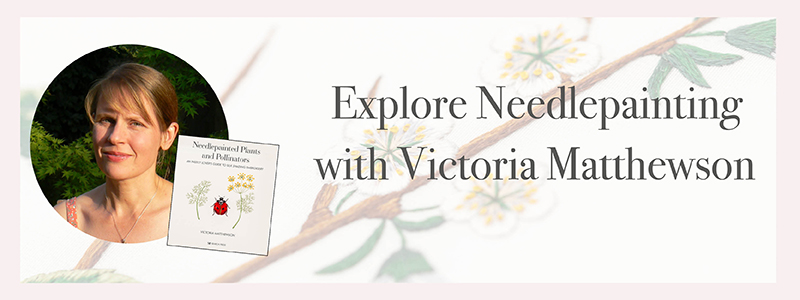
Victoria Matthewson is a self-taught hand embroidery artist whose work focuses on her love of nature in her exquisitely detailed needlepainted embroideries, which is formally known as silk shading. Victoria is also renowned as one of the top silk shading artists in the UK and has won several accolades, such as the Needlecrafter of the Year in 2018 at the National Needlecraft Awards in collaboration with DMC thread, for her embroidered ladybird.
We caught up with Victoria to talk about her stunning new book (if we do say so ourselves!), Needlepainted Plants and Pollinators, her designated craft space and more!
Hi Victoria, how are you?
I am well thanks. I'm excited about the release of my book!
How did your love for embroidering begin?
Like many people, I learnt the basics of cross stitch at primary school; I found it fascinating and wanted to learn more. The school had asked us to stitch square houses and dogs but I wanted to be a little more adventurous, so I took myself off to the local library and found books on cross stitch designs. I came back with a floral wreath and a Celtic border. It wasn’t until I was 21 and at drama school that I started experimenting with needlepainting as I sat in rehearsals and embroidered my graduation dress. After the birth of my second daughter I started to really try and develop my needlepainting skills and it was a tip from the artist Helen M Stevens that made me try silk floss thread. I was hooked from the moment I tried it, the detail that can be achieved and the wonderful depth of colour and shine help to create such beautiful lifelike images.
Where do you get your inspiration for your embroidery pieces from and how long do they take to create?
My inspiration comes from the nature that surrounds me. Exotic plants and animals can be fascinating but we often overlook the amazing diversity that can be found in our local area. You can find inspiration in your back garden or take time when you are out on a walk to stop and look, your local park can be a thriving ecosystem if you look closely.
I have always liked to try and work from my own source material so photographing the flora and fauna that is specific to my local area ensures that my embroideries are completely original.
Needlepainting, especially with silk thread, is not a quick art. Building up the stitches in each embroidery can take weeks to months to create. I always say that the main skill you need to have to create this sort of embroidery is patience.
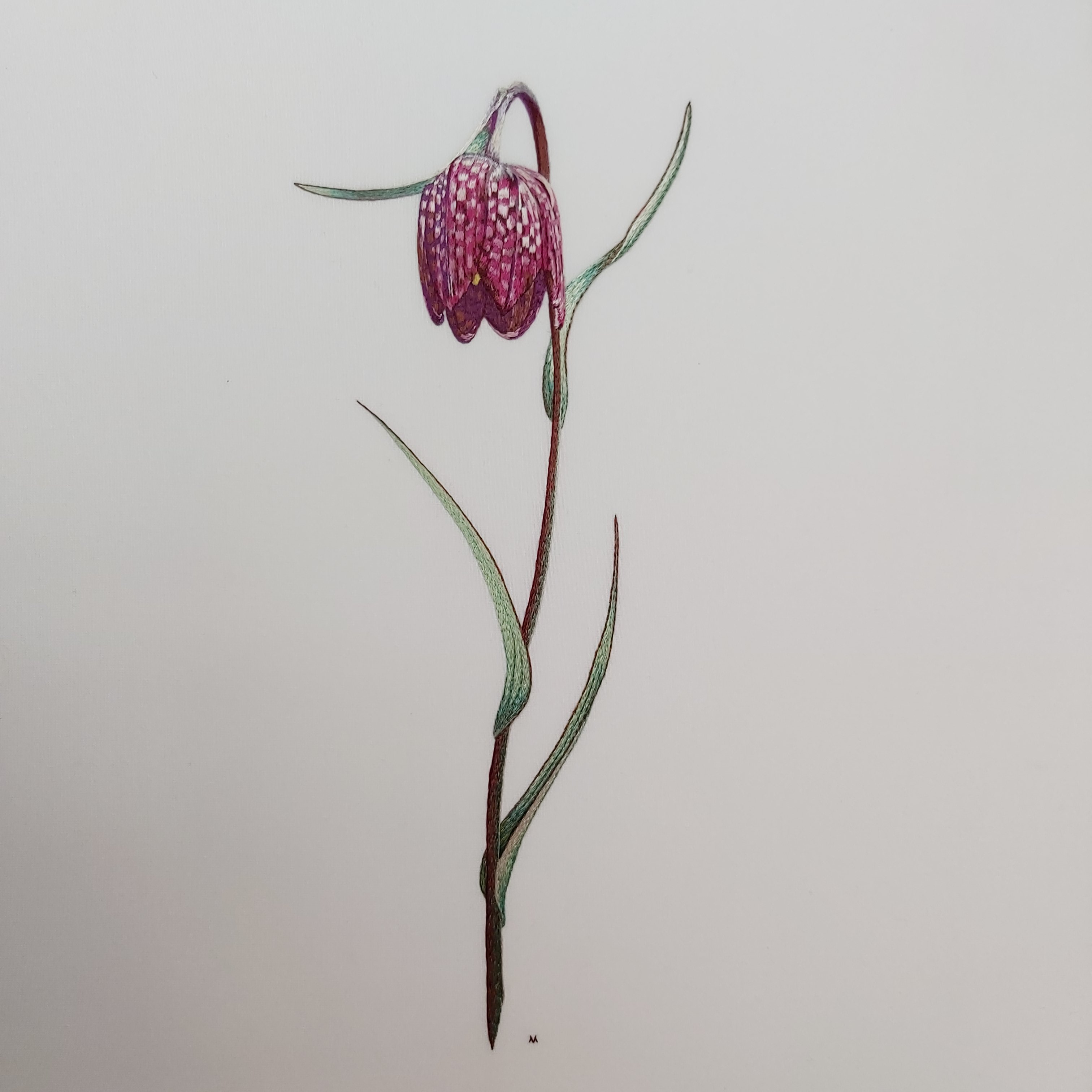
Is there a particular place where you designate space to do your embroideries?
I used to embroider in our lounge but I was gradually taking over the space, so I decided to build a small 7’x 5’ summerhouse in the garden. My sewing shed isn’t glamorous, but I love having my own space that is always set up and ready to go. I finally had electricity linked up to it last year, so it has really become my own official office.
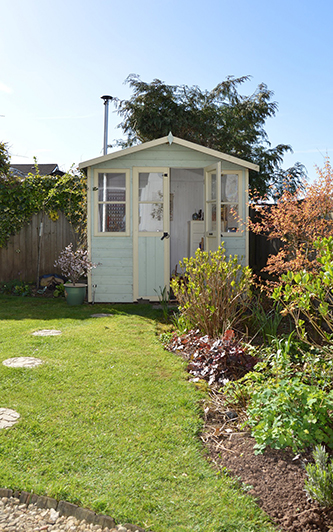
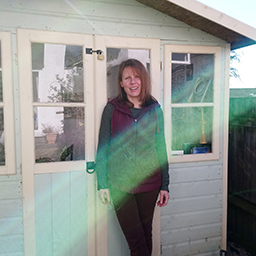
Congratulations on the release of your book, Needlepainted Plants and Pollinators! Can you tell us a bit about the book and what inspired you to write it?
Thank you! People often ask me for tips on creating silk shading embroidery and I saw this as an opportunity to share the experience I have gained in the years I have been practising. Needlepainted Plants and Pollinators is essentially an embroidery book, but it also aims to educate and inspire. I have included information on each insect and plant and general information on the decline in our insect numbers and how all of us can help in our own small way. I have become known for my embroideries of insects so I thought this would be a perfect chance to try and champion the invertebrates that are often overlooked and need our help now more than ever. People will often support slogans saying ‘save the bees’, and they will immediately think of honeybees, however, honeybees are not in any danger of becoming extinct. Pollinating insects are wide and varied, from the many solitary and bumble bees to wasps, flies, beetles, moths and butterflies, and it is many of these species that need our help due to rapidly declining numbers. Often these insects are overlooked or even hated without us having a good understanding of their importance in our ecosystem. I have found that I have gained a real respect for them through the slow paced, repetitive movement of embroidery and it is my hope that people will see that there is so much more to these invertebrates if they have a go themselves. Sometimes we can feel as if we are too small to make a difference, but by championing the even smaller creatures that are so important to the balance of this world I hope I am putting my skills to good use.
What is your favourite section of the book and why?
I was so excited when Iolo Williams agreed to write the forward for my book as he is someone I have respected for a long time. Of the projects I would say that the Gatekeeper Butterfly and Bramble is my favourite, I love the end of summer going into autumn and the blackberries and autumn colours make me smile. I could have designed a brightly coloured butterfly like the small tortoiseshell or the red admiral but I think the small, brown, fluttering wings of the Gatekeeper are so cheerful.
I also feel a real sense of pride when I look at the photos of insects that have been included, all of them were taken on either my phone or digital camera. There were many family walks that were held up while I stopped to try and take photos of interesting bugs I had spotted.
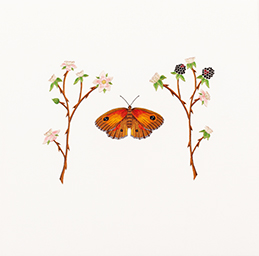
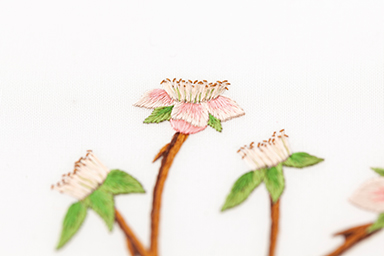
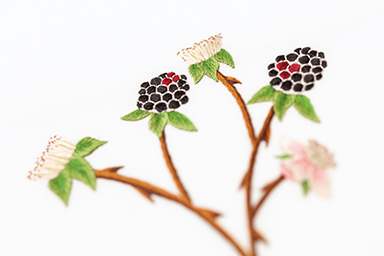
You’re also a member of The Society for Embroidered Work, how did you become involved in the society?
The Society for Embroidered Works (S.E.W) started in 2018 by two talented artists, Cat Frampton and Emily Tull. They started the society to fight the long-held opinion that embroidery is a craft and not an art, an idea with its roots firmly planted in misogyny. Embroidery is often thought of as being a ‘woman’s hobby’ with no real artistic merit; I myself have had comments such as ‘do you sit and embroider like some princess in a tower’. By having a society behind it and holding textile based exhibitions it is hoped that embroidery can be held up as the artform it truly is and be respected alongside other art such as oil painting and watercolour.
The society holds calls from time to time where textile artists can apply to join by submitting examples of their work. For more information you can visit www.societyforembroideredwork.com
Do you have any exciting plans for the rest of the year?
I will be telling the world about my book over the next couple of months but I am also working on a new piece for an exhibition next year called Fifty Bees. Curated by Lydia Needle, Fifty Bees is an exciting project that is now in it’s fifth year. Lydia creates 50 small, individual bee art pieces based on British bees and then invites 50 other artists, using their specific medium, to create a companion piece based on one of her specific creations. The exhibition aims to highlight the link between pollinators and our ecosystem. www.lydianeedle.com
Creating kits of my designs is something I have considered as I know that people can struggle to get hold of everything they need, especially the silk floss thread. Watch this space…
Needlepainted Plants and Pollinators is available from Search Press, RRP £19.99.
